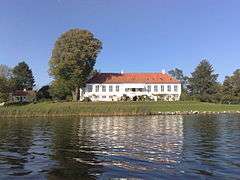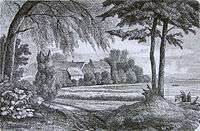Farumgård
| Farumård | |
|---|---|
 Farumgård viewed from Farum Lake | |
| General information | |
| Architectural style | Baroque |
| Location | Farum, Denmark |
| Country | Denmark |
| Coordinates | 55°48′21.54″N 12°21′38.64″E / 55.8059833°N 12.3607333°E |
| Completed | 1706 |
| Design and construction | |
| Architect | 1705 af François Dieussart |
Farumgård is a former manor house overlooking Farum Lake at Farum, Furesø Municipality, in the north-western outskirts of Copenhagen, Denmark. It is located just east of Farum Church and the original Farum village. The land has been sold off and redeveloped, except for the 6 hectares park which is laid out in the Baroque style.
History
The church and the crown
The first known reference to Farumgård is from 1370 when it was a farm under the Bishop Seat in Roskilde.[1] It was the administrative centre of their possessions around the villages of Farum, Lynge and Lillerød. From 1456 and for the next hundred years, the estate was held in fee by members of the Skovgaard family.
Farumgård was confiscated by the Crown in connection with the Reformation. The king generally put the estate at the disposal of lower-ranked officers and court officials, such as heralds, coachmen and court apothecaries. One of them was in the 16th century granted the necessary means for building a new half-timbered main building.[2]
Changing owners
In 1666, King Frederick III parted with the property when he ceded it to Hans Svane, who had laboured for the introduction of the hereditary monarchy in 1660, a favour he had already been generously rewarded for with appointments, titles and several other estates. Svane died just two years after he was granted Farumgaard and after that the estate changed hands numerous times.

20th century
Most of the land was sold off in lots in 1906. In 1910 the house and remaining land was acquired by Elisabeth Mozart Jensen, a wealthy widow, who owned it until her death in 1932. The property was then purchased by the German St. Ursula Sisters who ran it as a recovery home until 1960. In 1965 it passed back into private ownership and has remained in the same family since then.
Architecture
The current main building was completed in 1705. It was designed in 1705 by François Dieussart who was at the same time working on Sorgenfri House. It is a three-winged Rococo-style building.
Park
The park covers 6 hectares and was in 1913 returned to its former Baroque style by Elisabeth Mozart Jensen who owned Farumgaard from 1910 until 1932. The park was protected in 1965 and is considered one of the finest examples of Danish Baroque gardens.
References
- ↑ "Farumgaard" (in Danish). Gyldendal. Retrieved 2012-09-26.
- ↑ "Farumgård" (in Danish). Foreningen Naturparkens Venner. Retrieved 2012-09-26.
External links
| Wikimedia Commons has media related to Farumgård. |
- Images on photo-gallery.dk
